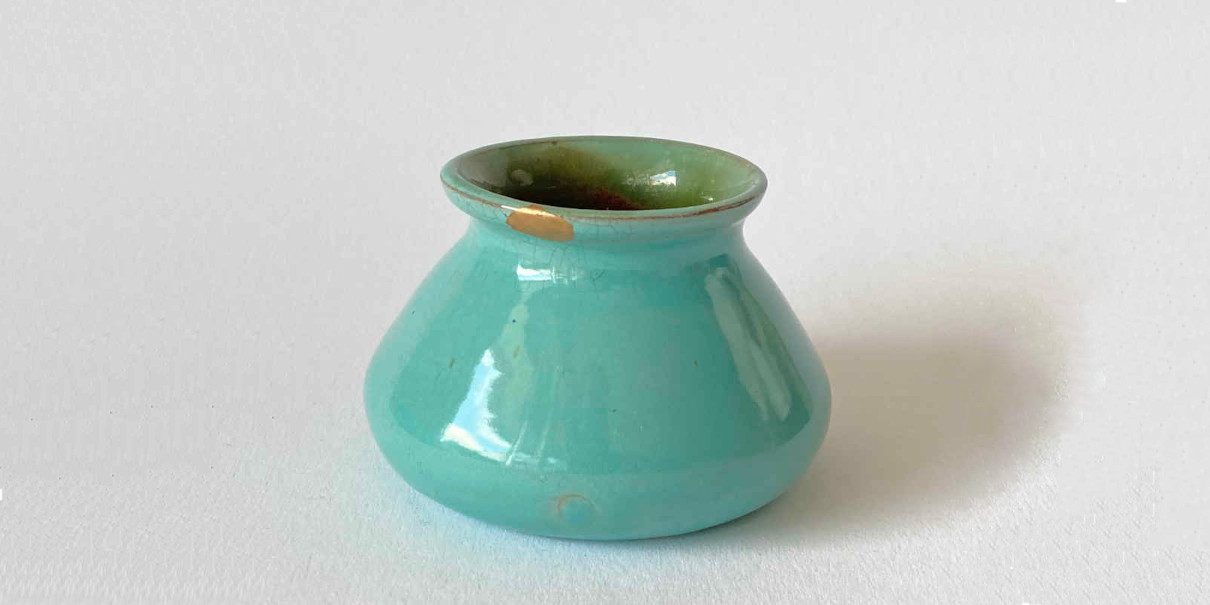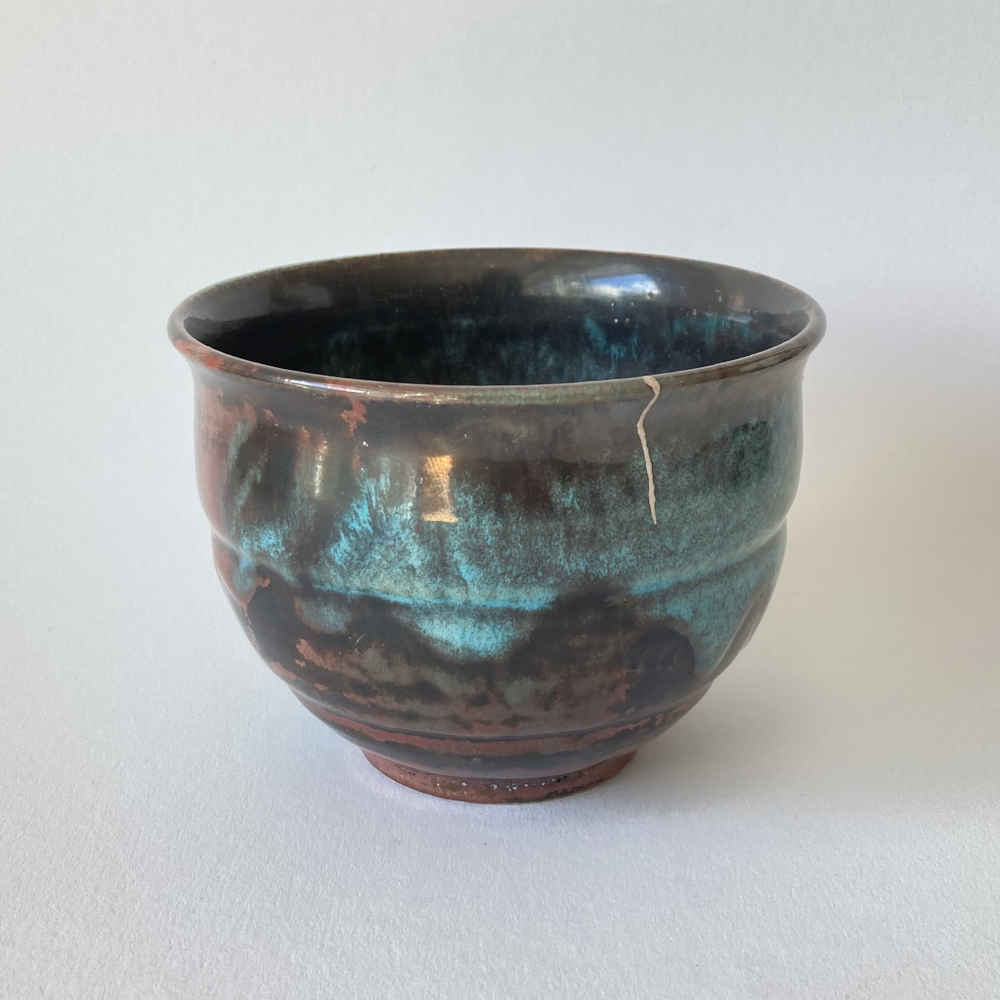If you would like to have a ceramic repaired or porcelain repaired, using the Japanese Kintsugi technique, then make an inquiry to our Ceramic Repair Service in Zurich, Switzerland (email address below), and let us give you an estimate without obligation, provided we have free repair capacity; of course, you can also calculate the prices for Kintsugi repair yourself using the list below.
Get an estimate now for ceramic repair with kintsugi

Ceramic repair with kintsugi
Kintsugi is a Japanese technique for repairing ceramics that originally uses gold (Kin = gold, tsugi = join) to refine the repaired areas, but other metals can be used instead. However, with the japanese kintsugi technique, you can not only have broken ceramics repaired, but also have broken porcelain repaired. Traditionally, Japanese ceramic repair using the kintsugi method involves the use of urushi varnish, which is used both for final varnishing and for mixing masses, for example, to glue broken pieces of porcelain or ceramics or to fill gaps or remodel imperfections. Urushi lacquer, also known as chinese lacquer, rhus lacquer or japanese lacquer, is made from the sap of the lacquer tree, which is also called rhus verniciflua or rhus vernicifera.
If you want to repair a piece of chipped ceramic, you mix the urushi lacquer with some clay powder and water and repair the chipped area – also called chip – with it. After this mass has dried in a so-called muro – a special curing box, the area is sanded smooth and then painted with urushi lacquer. It may be necessary to repeat this step if there are still unevennesses. After each varnishing with urushi varnish, the ceramic or porcelain must be placed in the curing box again so that the urushi varnish cures properly. To repair larger imperfections in a ceramic by filling it with a mass, other masses can be made with urushi lacquer.
If you want to repair cracks in ceramics, you can run urushi lacquer into the crack and repeat this until the crack is sealed, placing the ceramic in the curing box between each treatment with urushi lacquer.
If you want to repair a crack in ceramic or have a hairline crack in ceramic repaired, you can also do this using the Kintsugi method, in which the crack or hairline crack is simply brushed with urushi lacquer. If the crack leaves a larger space than a hairline crack, the cracked ceramic is treated as one with a crack.
Broken pottery can also be repaired. In order to repair broken pottery, a mixture of flour, water and urushi varnish is first prepared, which is used to glue the broken pieces of a ceramic piece.
Finally, in the kintsugi technique, gold is traditionally used in the repair of pottery, which is sprinkled on a final layer of urushi lacquer in the form of powder. However, instead of gold, other metals can be used, such as silver or brass. Ceramic repair using the Japanese Kintsugi technique, in which silver is used instead of gold at the end for finishing, is also called Gintsugi repair (gin = silver, tsugi = join).

Prices for repair
Prices for repairing a ceramic piece with the kintsugi technique depend on the type of damage (crack, gap/missing piece, broken piece) and the type of repair (with metal or without metal, type of metal, apply metal on both sides or only on one side, for example, in the case of a broken plate, apply metal both on the top of the plate and under the plate (both sides), or only on the top of the plate (one side). The centimeter count counts separately for each side.)
Prices for crack repair
- Basic price for repairing the crack up to 5 cm: 25 CHF
- from 5 cm crack length for each additional centimeter to be repaired: additional 5 CHF per cm
- if gold finishing of the repaired crack: additional 5 CHF per cm
- if silver finishing of the repaired crack: additional 3 CHF per cm
- if brass finishing of the repaired crack: additional 2 CHF per cm
Prices for gap filling or remodeling of missing parts
- Basic price for gap filling or remodeling of missing parts up to 1 cm²: 60 CHF
- from 1 cm² for each additional square centimeter: additional 5 CHF per cm²
- if gold finishing of the repaired area: additional 15 CHF per cm²
- if silver finishing of the repaired area: additional 10 CHF per cm²
- if brass finishing of the repaired area: additional 7 CHF per cm²
Prices for gluing together broken pieces
- Basic price for gluing together broken pieces up to 10 cm broken length: 50 CHF
- from 10 cm break length for each additional centimeter to be glued: additional 5 CHF per cm
- if gold finishing of the glued break line: additional 5 CHF per cm
- if silver finishing of the glued break line: additional 3 CHF per cm
- if brass finishing of the glued break line: additional 2 CHF per cm
Procedure and duration
The duration of a kintsugi repair is approximately between 5 and 8 weeks, whereby the exact duration depends, among other things, on the type of damage to be repaired as well as on whether the repaired area(s) is/are still to be finished with metal powder and how large our capacities are.
The procedure of ceramic repair with kintsugi method is as follows:
1. first, you would need to inquire with us if we have capacity to repair your ceramic or porcelain. You can also combine this request with a request for an estimate, which you will receive if we have capacity. Please send your request to the following e-mail address:
robert.zueblin@robertzueblin.com
(please note our privacy and data protection policy)
2. if we have free capacity to repair your pottery or porcelain and you agree with the cost, we will email you our Swiss address (in Zurich) to which you will then please send your pottery or porcelain.
- Costs by shipping within Switzerland:
You have to bear the costs for the Hinsendung (i.e. for shipping and packaging), we will bear the shipping and packaging costs for the return. - Costs by shipping to Switzerland and from Switzerland abroad:
You shall bear the costs for the outbound shipment (i.e., for shipping and packaging, plus the costs for any taxes, customs duties and customs clearance costs of the carrier that may be incurred); we shall bear the shipping and packaging costs for the return shipment; you shall bear any taxes, customs duties and customs clearance costs of the carrier.
3. performance of kintsugi repair on damaged ceramics or damaged porcelain.
4. return of the repaired ceramics to the address provided by you.
5. payment of the Kintsugi repair within 30 days after receipt of the repaired ceramics by Paypal or by bank transfer to our Swiss bank account or German bank account.
Cost estimate for ceramic repair with kintsugi technique
We will be happy to provide you with a cost estimate for the repair of your ceramics using the Kintsugi method, provided we have free capacity for the repair. This cost estimate is non-binding for you.
Please send us a photo of the item to be repaired to the following e-mail address so that we can process your request:
robert.zueblin@robertzueblin.com
(please note our privacy and data protection policy)


